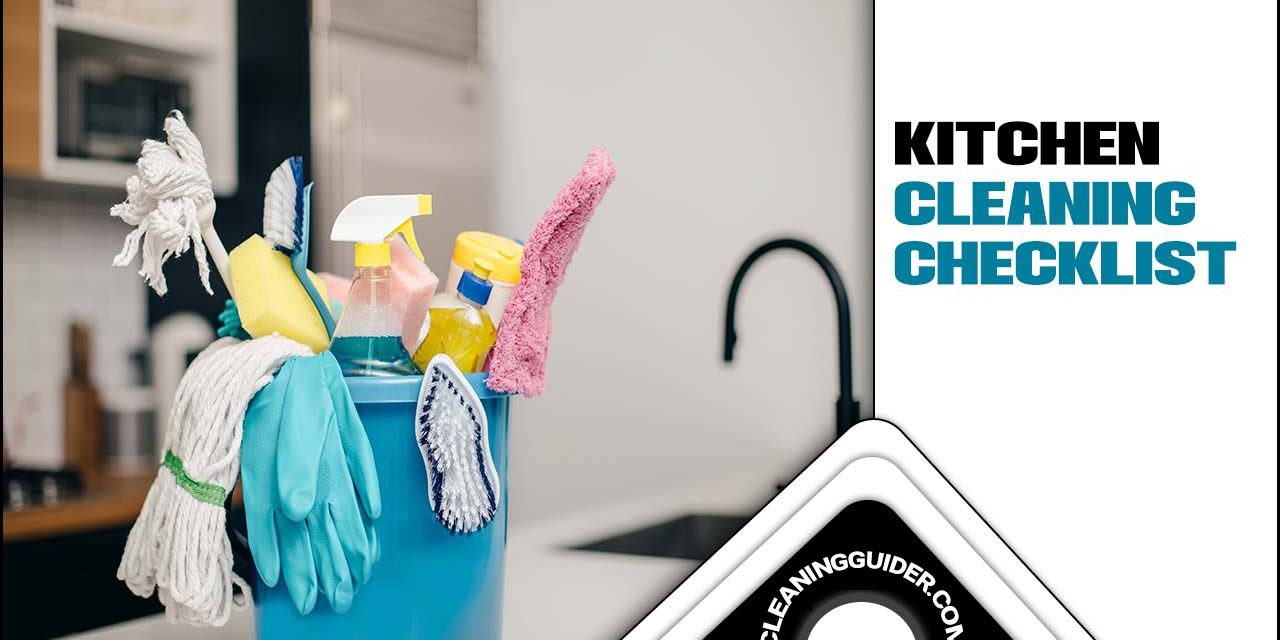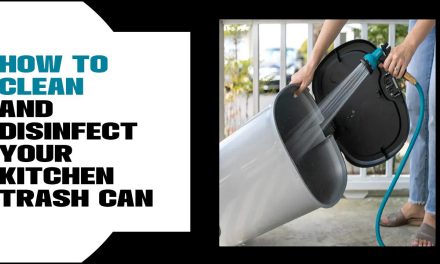Keeping your kitchen clean and organized is essential for maintaining a healthy and functional living space. However, with the hustle and bustle of daily life, it can be easy to let the cleanliness of your kitchen slip through the cracks.
That’s where a kitchen cleaning checklist comes in handy. By creating a comprehensive list, you can ensure that no area of your kitchen is overlooked and that every surface is thoroughly sanitized.
We will provide you with a detailed kitchen Cleaning-Checklist that covers all the essential tasks, from wiping down countertops to deep cleaning appliances. Whether you are a busy parent, a working professional, or simply looking to stay on top of your household chores, this checklist will serve as a helpful guide to maintaining a spotless and welcoming kitchen.

Kitchen Cleaning Tools

Knowing the various kitchen cleaning tools is of utmost importance for maintaining a clean and hygienic environment in any food preparation area. With the ever-increasing focus on food safety and sanitation, professionals and home cooks alike need to be well-versed in the proper use of these tools.
One key reason why it is important to know kitchen cleaning tools is to Understand which tool to use for each task to ensure that harmful bacteria or allergens are not spread from one surface to another, ultimately safeguarding the health of individuals consuming the prepared food.
- Sponge: Used for washing dishes, countertops, and other surfaces.
- Dishcloth: Ideal for drying dishes and wiping down surfaces.
- Scrub Brush: Helps remove tough stains and grime from pots, pans, and surfaces.
- Dish Scrubber: Designed to clean dishes and utensils more effectively than a sponge.
- Microfiber Cloth: Great for dusting and polishing surfaces.
- Broom And Dustpan: Essential for sweeping up crumbs and debris on the floor.
- Mop: Used to clean and disinfect the kitchen floor.
- Squeegee: Helps remove water and streaks from windows and countertops.
- Glass Cleaner: Specifically formulated to clean glass surfaces without leaving streaks.
- All-purpose cleaner: Versatile cleaning solution for various surfaces and appliances.
- Oven Cleaner: Designed to remove grease and baked-on food from the oven.
- Degreaser: Useful for removing stubborn grease and grime from kitchen surfaces.
- Rubber Gloves: Protect your hands while using cleaning chemicals
Kitchen Cleaning Checklist: A Step-By-Step Guide
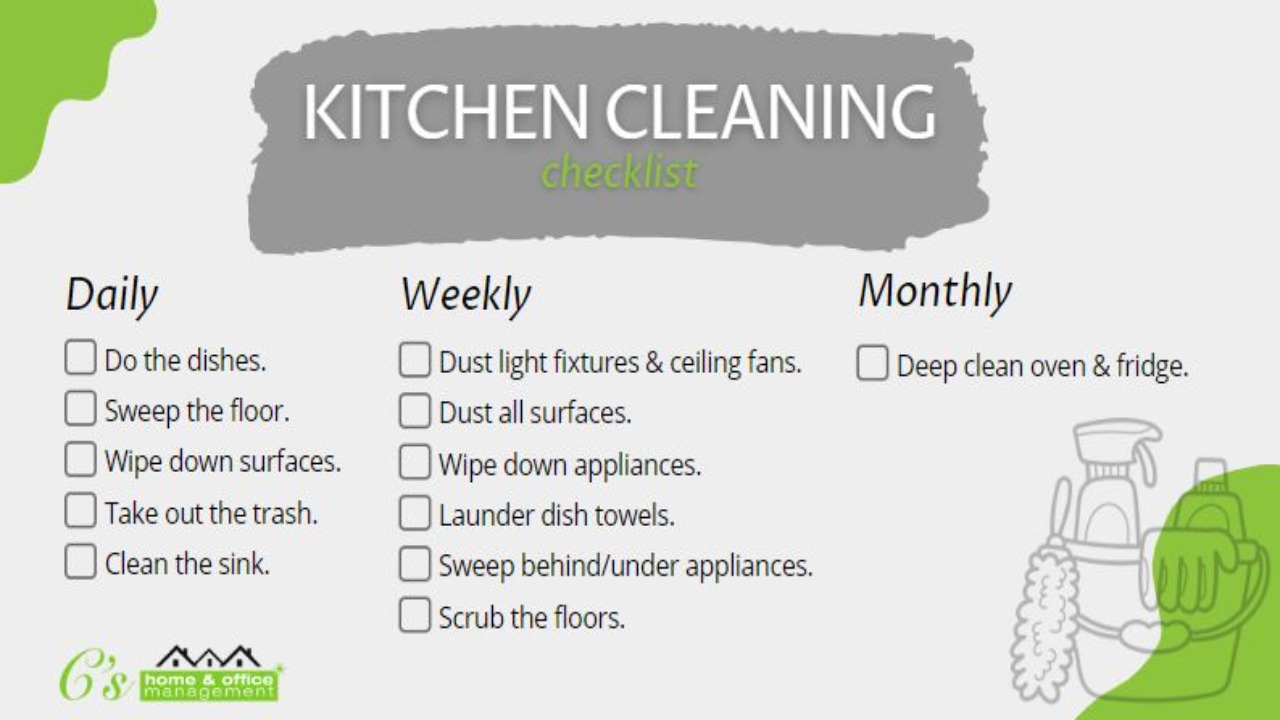
Understanding and implementing a kitchen cleaning checklist is of utmost importance in maintaining a clean and hygienic environment in any food-related establishment. The kitchen is the heart of any food service operation, be it a restaurant, hotel, or café, and it plays a critical role in the preparation and serving of meals to customers.
Therefore, ensuring that the kitchen is clean and meets the highest standards of cleanliness is not only an essential part of running a successful business, but it is also vital for the health and safety of both employees and customers. Here, we will give you Kitchen Cleaning-Checklist
Everyday Kitchen Cleaning

Maintaining a clean and organized kitchen is essential for both hygiene and efficiency. A cluttered and dirty kitchen can be a breeding ground for bacteria and can lead to foodborne illnesses. Plus, a disorganized kitchen can make it difficult to find utensils and ingredients, leading to unnecessary frustration and wasted time.
Implementing an everyday kitchen cleaning routine can help ensure that the heart of your home remains a welcoming and functional space. To effectively tackle kitchen cleaning tasks, it is advisable to follow a kitchen Cleaning-Checklist.
- Wipe down countertops and surfaces.
- Clean and sanitize the sink
- Sweep or vacuum the floor
- Clean and sanitize stove top
- Wash and dry dishes
- Empty and clean garbage can
- Clean and sanitize refrigerator handles
- Wipe down appliances such as microwave and toaster
- Clean and sanitize cutting boards
- Organize and tidy up cabinets and pantry
- Clean and sanitize kitchen utensils
- Clean and sanitize kitchen towels and dishcloths
- Clean and sanitize kitchen sink strainer
- Clean and sanitize kitchen faucet and handles
- Dispose of expired food items in the refrigerator and pantry
- Clean and sanitize the kitchen sponge or replace it if necessary.
Kitchen Cleaning Tasks For The Week
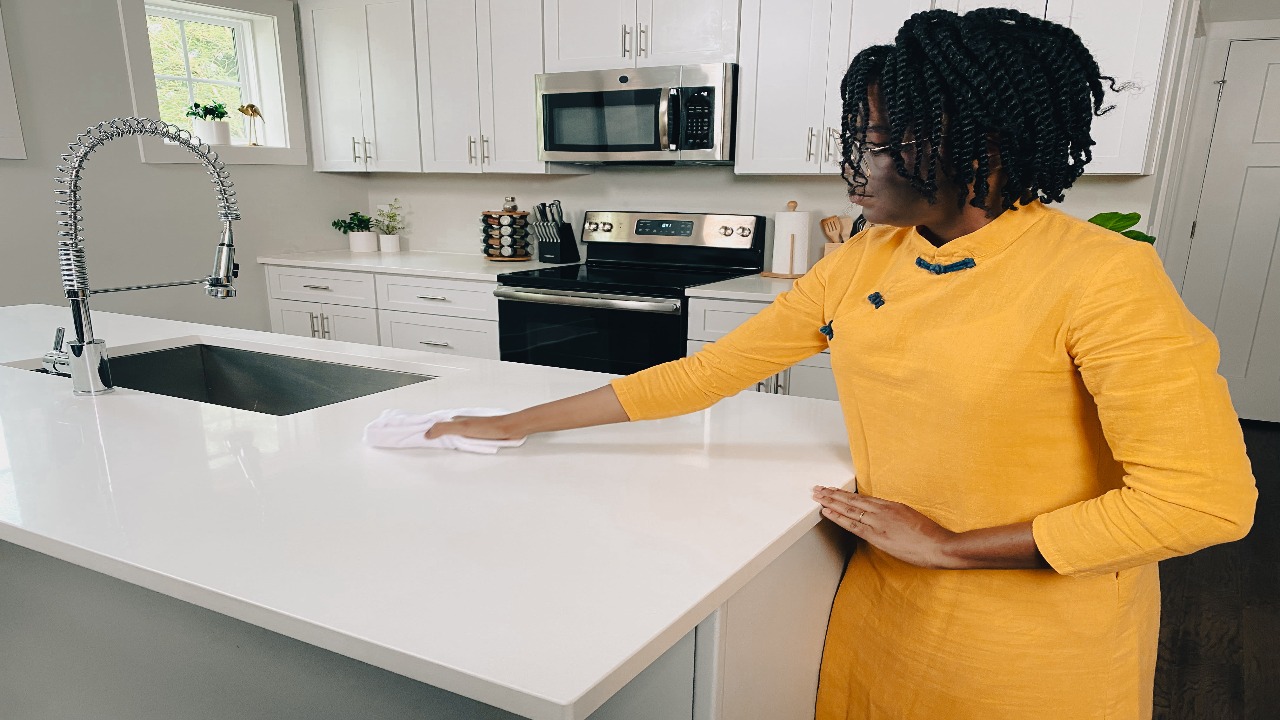
In a professional kitchen environment, maintaining cleanliness is of utmost importance. It not only promotes a hygienic space but also ensures the safety and well-being of both employees and customers. That’s why kitchen staff must be knowledgeable about the various kitchen cleaning tasks that need to be performed on a weekly basis. Understanding the importance of knowing kitchen cleaning tasks for the week is essential for several reasons.
- Monday: Clean and sanitize countertops and kitchen surfaces
- Tuesday: Wipe down and organize pantry shelves
- Wednesday: Scrub and disinfect the sink and faucet
- Thursday: Clean the stovetop, including removing any grease or food residue
- Friday: Empty and clean out the refrigerator, checking for expired items
- Saturday: Sweep and mop the kitchen floor
- Sunday: Deep clean the oven and microwave, removing any spills or buildup
Monthly Routine For Kitchen Cleaning
Knowing and following a monthly routine for kitchen cleaning is of utmost importance for maintaining a clean and hygienic environment in any food establishment. A kitchen is a bustling environment where food is prepared and served, making it prone to accumulating dirt, grease, and bacteria. By having a structured monthly Cleaning-Checklist, kitchen staff can ensure that every nook and cranny of the kitchen is thoroughly cleaned and sanitized on a regular basis.
- Empty and clean out the refrigerator, removing any expired or spoiled food.
- Deep clean the oven, including scrubbing the oven racks and wiping down the interior.
- Clean the microwave, ensuring the interior and exterior are free from spills and stains.
- Clean and descale the coffee maker, removing any built-up residue.
- Wipe down and disinfect countertops, paying special attention to areas around the sink and stove.
- Clean and organize pantry shelves, discarding any expired or unused items.
- Dust and wipe down all kitchen cabinets and drawers, inside and out.
- Clean and disinfect the sink, including the faucet and drain.
- Polish stainless steel appliances to remove any fingerprints or smudges.
- Scrub and disinfect the kitchen floor, paying attention to corners and hard-to-reach areas.
Seasonal Kitchen Cleaning-Checklist
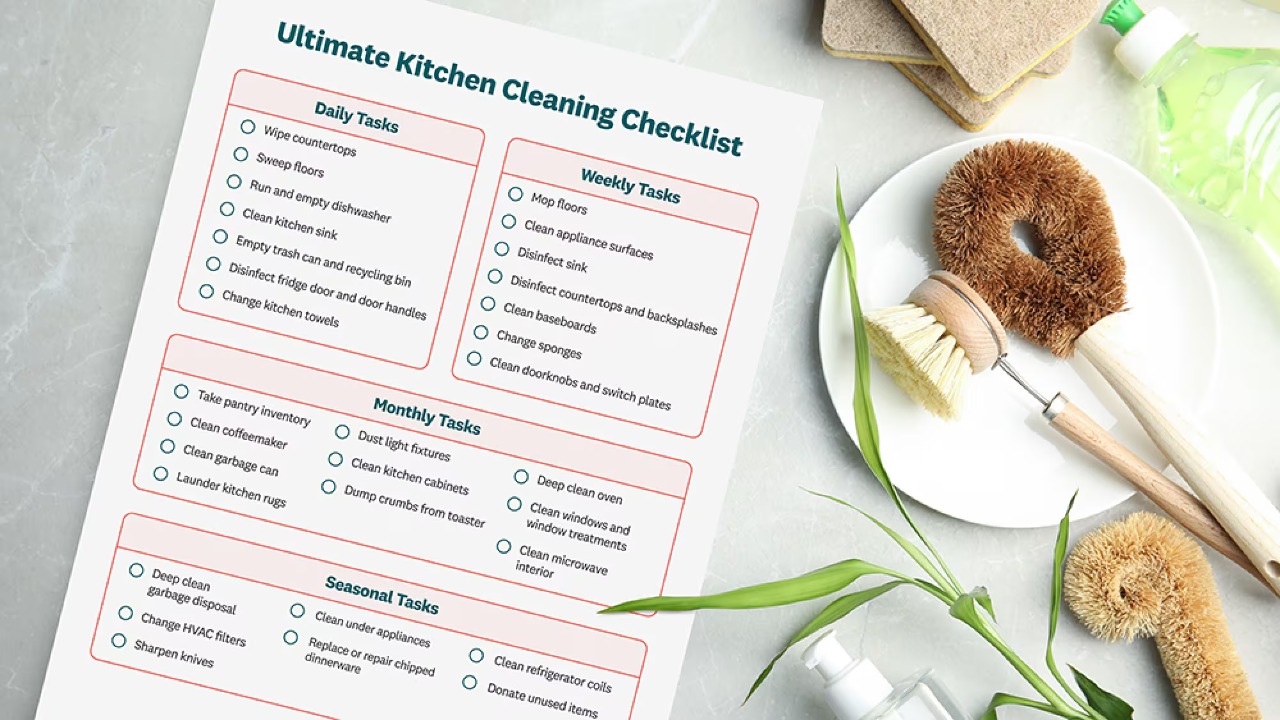
In the culinary industry, maintaining a clean and organized kitchen is of utmost importance. It not only ensures food safety and hygiene but also contributes to the overall efficiency and productivity of the kitchen staff.
A seasonal kitchen Cleaning-Checklist is an essential tool that helps in maintaining high standards of cleanliness throughout the year. A seasonal kitchen Cleaning-Checklist ensures that all areas of the kitchen are thoroughly cleaned and sanitized on a regular basis.
- Clear out and organize the pantry and refrigerator
- Deep clean oven, stove, and microwave
- Descale and clean coffee maker
- Clean and organize kitchen cabinets and drawers
- Wash and disinfect all countertops and surfaces
- Clean and organize kitchen sink and faucet
- Dust and wipe down light fixtures and ceiling fans
- Empty and clean out the dishwasher
- Wash and disinfect all kitchen utensils and cooking tools
- Clean and disinfect cutting boards
- Empty and clean out the trash can
- Vacuum and mop the kitchen floor
- Clean and polish stainless steel appliances
- Check and replace any expired food items
- Wash and disinfect kitchen towels and dishcloths
Kitchen Appliance Cleaning Tasks
In today’s fast-paced society, where time is a valuable commodity, it can be easy to overlook certain tasks, such as cleaning our kitchen appliances. However, understanding the importance of regularly cleaning these appliances is crucial for several reasons. Maintaining a clean kitchen is essential for food safety. Our appliances, such as ovens, microwaves, and refrigerators, come into direct contact with our food on a daily basis.
- Clean The Refrigerator: Remove all items, discard expired food, wipe down shelves and drawers, and clean the exterior with a suitable cleaner.
- Clean The Oven: Remove racks and clean them separately. Use an oven cleaner to remove grease and food residue from the interior, and wipe down the exterior with a damp cloth.
- Clean The Stovetop: Remove burner grates, clean them thoroughly, wipe down the stovetop surface with a degreaser, and clean any knobs or control panels.
- Clean The Microwave: Remove any removable parts, clean the interior with a microwave-safe cleaner or a mixture of water and vinegar, wipe down the exterior, and clean the control panel.
- Clean The Dishwasher: Remove any food debris from the filter, wipe down the interior, run a cleaning cycle with a dishwasher cleaner or vinegar, and wipe down the exterior.
- Clean The Coffee Maker: Run a cycle with a mixture of water and vinegar, rinse thoroughly, wipe down the exterior,
Quarterly Kitchen Cleaning-Checklist
Knowing and implementing a quarterly kitchen Cleaning-Checklist is of utmost importance for several reasons. Maintaining a clean and sanitary kitchen environment is crucial in ensuring the safety and well-being of both employees and customers.
A dirty and unorganized kitchen can harbor harmful bacteria, leading to foodborne illnesses and potential health risks. By adhering to a comprehensive quarterly Cleaning-Checklist, businesses can minimize the chances of contamination and create a hygienic space for food preparation.
- Clean and disinfect all countertops and surfaces
- Empty and clean out the refrigerator, including removing expired food items
- Deep clean the oven, including removing and cleaning the oven racks
- Clean and descale the coffee maker or kettle
- Wash and sanitize all cutting boards and utensils
- Clean and organize the pantry, checking for expired items
- Scrub and disinfect the sink and drain
- Clean and degrease the stove and range hood
- Clean and polish all stainless steel appliances
- Wash and disinfect the microwave inside and out
- Clean and sanitize the dishwasher, including running a cleaning cycle
- Wash and disinfect all kitchen linens, such as towels and oven mitts
- Wipe down and sanitize all cabinet doors and handles
- Clean and shine the windows and window sills
- Sweep and mop the floors thoroughly, paying attention to corners and hard-to-reach areas
How To Stick To A Kitchen Cleaning Schedule
Maintaining a clean and organized kitchen is essential for several reasons. Firstly, it ensures food safety and hygiene. By adhering to a kitchen cleaning schedule, you can minimize the risk of cross-contamination and foodborne illnesses.
Regularly sanitizing countertops, utensils, and cooking surfaces helps eliminate harmful bacteria and ensures that your meals are prepared in a safe environment. Secondly, a well-maintained kitchen promotes efficiency and productivity.
- Set A Specific Cleaning Schedule: Determine the frequency of cleaning tasks and assign specific days or times for each task.
- Create A Checklist: Make a checklist of all the cleaning tasks that need to be done in the kitchen, such as wiping countertops, cleaning appliances, and organizing cabinets.
- Prioritize tasks: Identify which tasks are the most important or need to be done more frequently and prioritize them accordingly.
- Break Down Tasks: Instead of tackling all the cleaning tasks at once, break them down into smaller, manageable tasks that can be done daily or weekly.
- Set Reminders: Use reminders or alarms on your phone or calendar to prompt you when it’s time to clean the kitchen.
- Establish a routine: Incorporate cleaning tasks into your daily or weekly routine so that it becomes a habit.
- Delegate Responsibilities: If you live with others, assign specific cleaning tasks to each person to ensure that the workload is shared.
- Stay Organized: Keep cleaning supplies readily available and organized, making it easier.
Keep Your Kitchen Spotless Naturally With Puracy
Maintaining a clean and hygienic kitchen is essential for a healthy and inviting home environment. With Puracy’s range of natural cleaning products, you can effortlessly keep your kitchen spotless without compromising on safety or effectiveness. Puracy offers a unique selection of plant-based, non-toxic formulas that are specifically designed to tackle tough kitchen messes while being gentle on surfaces and the environment.
Puracy’s commitment to using only premium, plant-derived ingredients ensures that you can confidently clean your kitchen without the worry of harsh chemicals or residues.
Their products are free from sulfates, parabens, and other harmful additives, making them safe to use around food preparation areas and for individuals with sensitivities or allergies. The natural scents derived from essential oils used in Puracy’s formulas provide a refreshing and invigorating cleaning experience.
Tips For Sticking To A Kitchen Cleaning-Checklist
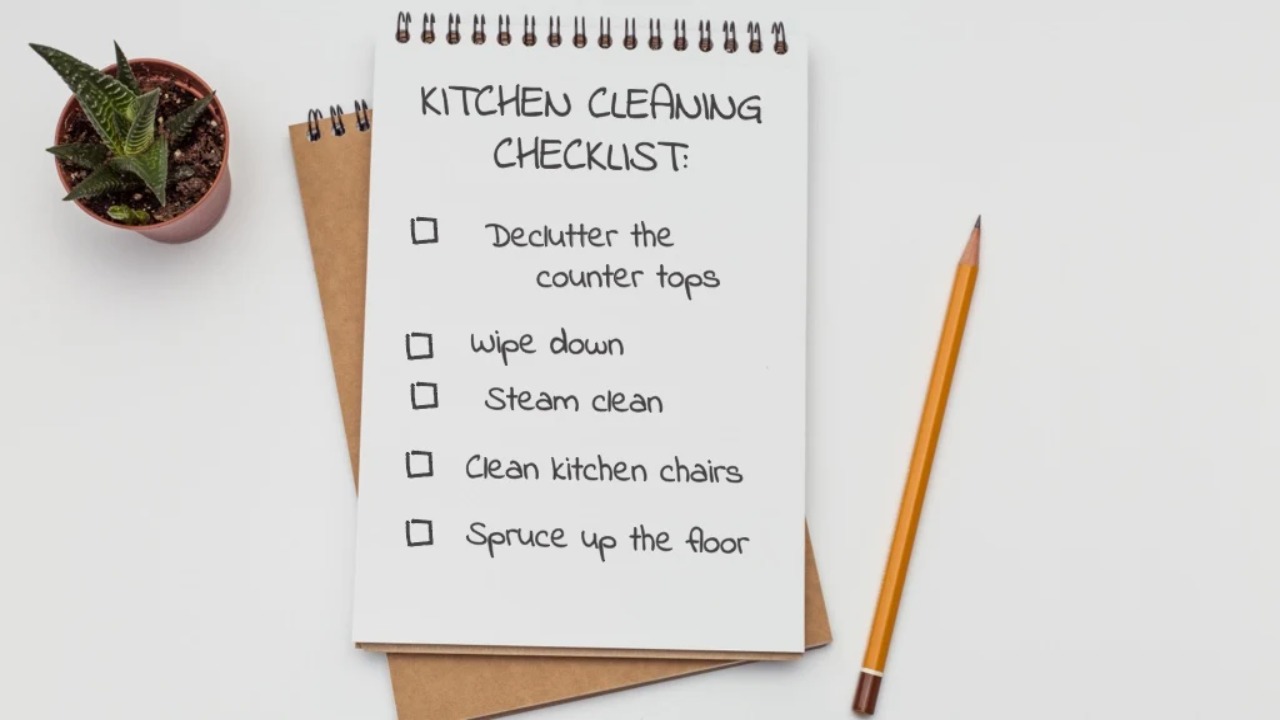
In the fast-paced world we live in, maintaining a clean and organized kitchen can often be a daunting task. However, it is of utmost importance to know and implement effective tips for sticking to a kitchen Cleaning-Checklist.
Firstly, adhering to a Cleaning-Checklist ensures a hygienic and safe environment in the kitchen. Regular cleaning and sanitization prevent the growth of bacteria, mold, and other harmful contaminants that can compromise the health of individuals consuming meals prepared in the kitchen.
- Set A Regular Cleaning Schedule: Plan specific days and times to clean your kitchen and stick to them.
- Break Down Tasks: Divide your kitchen Cleaning-Checklist into smaller, manageable tasks to make it less overwhelming.
- Prioritize Tasks: Start with the most important or time-sensitive tasks first to ensure they get completed.
- Set Realistic Goals: Don’t overload your Cleaning-Checklist with too many tasks. Be realistic about what you can accomplish in a given timeframe.
- Use A Timer: Set a timer for each task to help you stay focused and avoid spending too much time on one task.
- Get Organized: Keep your cleaning supplies and tools easily accessible to save time and avoid distractions.
- Involve The Family: Assign specific tasks to each family member to distribute the workload and make cleaning a shared responsibility.
- Reward Yourself: After completing each task or the entire checklist, reward yourself with something you enjoy, like a treat or a break.
Conclusion
A clean kitchen is a happy kitchen. It’s not just a saying. It’s a fact. A hygienic and functional kitchen is essential for a healthy and efficient cooking experience. Following a kitchen cleaning-checklist is an essential part of maintaining a hygienic and functional kitchen. By systematically tackling each task on the checklist, you can ensure that your kitchen is not only spotless but also safe for food preparation.
Remember to regularly review and update your checklist to suit your specific kitchen needs. With a little bit of effort and consistency, you can keep your kitchen in top shape and enjoy the benefits of a clean and organized cooking space. If you read the above outline properly, we hope you now understand the kitchen cleaning checklist
FAQ
1.Why Is It Important To Have A Kitchen Cleaning-Checklist?
Ans: Having a kitchen Cleaning-Checklist helps ensure that all areas and appliances in the kitchen are regularly cleaned, promoting a hygienic and safe cooking environment.
2.What Are Some Essential Tasks To Include In A Kitchen Cleaning-Checklist?
Ans: Some key tasks to include are wiping down countertops, cleaning appliances, sanitizing sinks, and organizing the pantry and refrigerator. To achieve this, there are a few key tasks that we must include in our regular cleaning routine.
3.How Often Should A Kitchen Cleaning-Checklist Be Followed?
Ans: It is recommended to follow a kitchen Cleaning-Checklist at least once a week, but certain tasks like wiping down countertops should be done daily.
4.What Are The Benefits Of Using A Kitchen Cleaning-Checklist?
Ans: Using a checklist helps maintain cleanliness and order in the kitchen, prevents the buildup of dirt and grime, reduces the risk of foodborne illnesses, and saves time by providing a systematic approach to cleaning.
5.What Are Some Essential Tasks On A Kitchen Cleaning-Checklist?
Ans: Some essential tasks on a kitchen Cleaning-Checklist may include wiping down countertops, cleaning appliances, sanitizing the sink, sweeping or mopping the floor, and emptying and sanitizing the trash bins.

